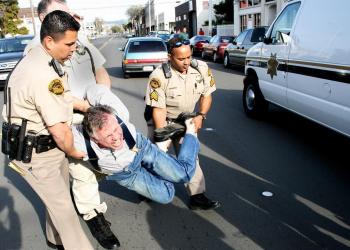
Resisting Arrest
It is reversible error for a trial court to instruct a jury in a criminal case that the defendant’s unlawful resistance to his arrest negates the prosecution’s need to prove that the officers acted in the lawful performance of their duties.
On December 18, 2018, defendant John Wesley Southard was observed by two California Highway Patrol (CHP) officers (Officers Brenton Dunaj and Spencer Good) on Highway 101 (a two-lane stretch of highway, with one lane in each direction) in Del Norte County, driving a pickup truck at about 35 mph in a 55-mile-per-hour speed zone. It was also observed that defendant was straddling the white line separating the roadway from the shoulder. Suspecting that the defendant might be driving while under the influence (but apparently not sure that they had enough), the officers followed him. Defendant eventually pulled to the side of the road and stopped on his own initiative. The officers pulled up behind him. At this point, it was observed that defendant’s license plate tab was expired. Although initially intending to conduct a consensual encounter only, at least until they were able to determine whether defendant was in fact driving while impaired, Officer Dunaj, upon noting the expired license plate tab, turned on their vehicle’s emergency lights. In so doing, the officers conceded in later testimony that by turning on their emergency lights, the situation had been converted into a detention. Officer Dunaj also later testified, in what the prosecutor conceded was confusing and contradictory testimony, that he activated his vehicle’s emergency lights due to the observed violation of V.C. § 21658 (requiring the driver to drive in a single lane), even though this statute only applies to roadways with two or more lanes in one direction, and even though Officer Dunaj did not list this section in his reports. In his arrest report, Officer Dunaj instead listed V.C. § 22107 (failure to signal a traffic lane change) because, as he testified, he considered driving over the line marking the edge of the roadway to be an unsafe movement. The Appellate Court also noted that Officer Junaj admitted in his testimony that “only one of (these Vehicle Code violations) seem[ed] to factually apply,” and that it was an infraction. However in testimony, both officers testified that they believed that defendant may have been DUI. But whatever the reason (see Note, below), defendant was considered to be detained at this point. Upon Officer Dunaj turning on the vehicle’s emergency lights, defendant got out of the pickup, ignoring the officers’ orders to stay in his vehicle. Instead, defendant took off running, getting about 200 feet before tripping and falling. Officer Dunaj caught up with defendant and, when defendant resisted, used his Taser on him a couple of times, “drive-stun(ning)” him in an attempt to subdue him. The struggle itself was captured on a cover officer’s body camera, the resulting video conflicting with Officer Dunaj’s testimony concerning whether defendant’s right hand was unsecured up until being handcuffed, and whether or not defendant was reaching for his right pocket in which two folding knives were later found. Officer Dunaj also, in his testimony, changed his account as to what had occurred, admitting that defendant’s right hand was underneath his body and not visible, and that he could not say whether defendant was in fact reaching for his right pocket. And just to complicate manners even more, the cover officer’s testimony conflicted with Officer Dunaj’s on the issue of the positioning of defendant’s right hand while resisting efforts to subdue him. But in either case, defendant was eventually taken into custody, charged with resisting arrest, and taken to jail. (Why he ran from the officers is never explained.) A week later, on Christmas day (Dec. 25), defendant was riding as a passenger in the right front passenger’s seat in another person’s (David Bonde’s) vehicle. At a little after 7:00 p.m., CHP Officer Tyler Krueger (presumably no relation to the “Freddie Krueger” of “A Nightmare on Elm Street” and subsequent horror movies fame) observed that the license plate light on Bonde’s car was not working. So he pulled his car over and contacted the vehicle’s occupants. Upon doing so, Officer Krueger recognized defendant, having been told about his December 18 arrest. While dealing with Bonde, Officer Krueger also asked defendant for his full name and date of birth, to which defendant responded by asking why he “was messing with” him. Officer Krueger decided to check defendant for warrants despite knowing that it was unlikely any existed because defendant had just been released from jail. While talking with Bonde, defendant unbuckled his seatbelt and moved his hand towards the center console. Defendant ignored Officer Krueger’s demand that he put his seatbelt back on, continuing to “dig . . . for something on his left side.” At this point, CHP Officer Brian Wilson arrived as backup. While Officer Wilson made small talk with defendant, Officer Krueger received information from dispatch that defendant did in fact have an outstanding felony warrant for his arrest. With a third officer (CHP Officer Levi Sackett) arriving at the scene, defendant was ordered to get out of the car. Defendant refused, denied that he had a warrant, and continued to dig between the seats to his left where at some point one of the officers observed a knife. More officers arrived, including Crescent City Police Department Officer Gene Votruba with his German Shepherd Django. Defendant violently resisted being extricated from the vehicle. But after breaking a window, and with the assistance of Django, Officer Krueger’s baton, and several officers’ Tasers, defendant was eventually subdued and arrested. At one point during the struggle, defendant was held to the ground by several officers putting their knees on his neck and back, with defendant screaming “I can’t breathe, I can’t breathe!” “That's illegal,” and “You're killing me!” (I wonder where he got that from.) Several knives were eventually recovered, along with a small canister of methamphetamine found in defendant’s belt. Defendant was given oxygen because he complained that he was having trouble breathing, and then taken to the hospital to be treated for dog bites. He was subsequently charged in state court with three counts of felony resisting arrest by force (P.C. § 69), four counts of misdemeanor resisting arrest (P.C. § 148(a)(1)), plus the possession of methamphetamine (H&S Code § 11377(a)). Convicted of all counts, plus a true finding on a prior prison term allegation, defendant was sentenced to five years and four months in state prison. Defendant appealed.





